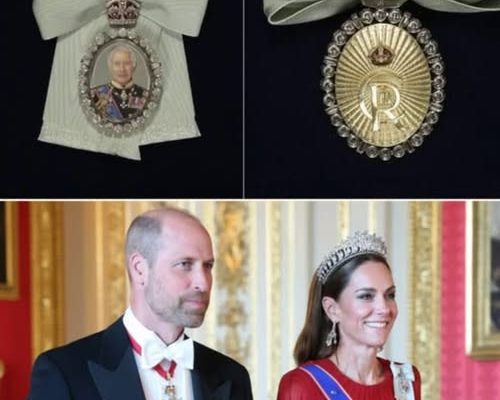Catherine, Princess of Wales, stepped back into the spotlight on July 8, 2025, her presence at Windsor Castle’s state banquet both triumphant and deeply moving. The occasion—a lavish evening in honor of French President Emmanuel Macron and First Lady Brigitte Macron—quickly became secondary to the real headline: Catherine’s first major public engagement since her cancer diagnosis. As she appeared beside King Charles III, Queen Camilla, and Prince William, her steady poise and quiet strength radiated through the glittering halls.
She wore a floor‑length crimson gown by Sarah Burton for Alexander McQueen, its sculpted cape whispering of resilience even as it swept the floor with elegance. The bold hue suited her perfectly, evoking both the passion with which she approaches her charitable work and the courage she has shown throughout her treatment. Conversations hushed as she entered, onlookers struck by the combination of softness in the gown’s draping and the unmistakable authority of its tailoring—an apt metaphor for the grace under pressure she’s demonstrated in recent months.
More than just a fashion statement, Catherine’s attire held rich symbolism. Pinned to her sash was the Royal Family Order of King Charles III, conferred upon her privately and displayed publicly for the first time that evening—an intimate mark of her father‑in‑law’s esteem. She also bore Queen Elizabeth II’s Royal Family Order, uniting the legacies of two monarchs and underscoring her unwavering dedication to service across generations. Completing the ensemble, she chose the Lover’s Knot Tiara, once adored by her late mother‑in‑law Princess Diana, alongside diamond drop earrings passed down from the late Queen herself. Each heirloom piece silently connected her to the past even as she charted a path forward.
Throughout the dinner, Catherine moved among dignitaries with genuine warmth, her discreet smiles and thoughtful exchanges conveying more than any scripted remarks could. At one table, she and Brigitte Macron shared a private laugh over family anecdotes; at another, she discussed her patronage of children’s mental‑health charities with a veteran ambassador. These candid moments reminded everyone that her return wasn’t simply a royal formality—it was a renewal of the empathy and compassion that have long defined her public role.
By evening’s end, the applause that greeted Catherine as she rose to leave felt less like protocol and more like collective relief and admiration. Her comeback was a vivid testament to resilience: she had confronted one of life’s greatest challenges and emerged determined to fulfill her duties with renewed vigor. In that historic banquet room—bathed in the glow of crystal chandeliers and the murmurs of international diplomacy—Catherine’s graceful return offered Britain a powerful symbol of hope. She reminded the world that true strength lies not in absence, but in showing up again, heart open and head held high.

